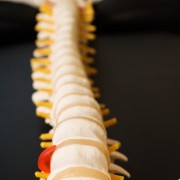 Photo: Getty Images
Photo: Getty Images
I am the guilty one--guilty of taking my back for granted. Unless it is giving me trouble of any kind, I usually do not think much about it. However, our spinal column, also known as our back bone, does a great deal of work for our bodies, and I suppose I should be grateful for the healthy one I have.
The spinal column is made up mainly of vertebrae, discs, and the spinal cord. Much like myself on any stress-filled day (translated: every day!), the spinal cord is comprised of a bundle of nerves, nerve cells, and fibers that are wrapped together going down from the brain to the lower back.
Vertebrae serve to protect the cord, and those vertebrae are separated by discs. As the brain sends electrical signals through the spinal cord, we can freely move our arms, legs, and other parts of our bodies.
Thirty-three vertebrae comprise the bone anatomy of the spinal column, and the last four are fused together to create the tailbone. A soft substance called a disc separates each vertebra. These discs cushion and seal simultaneously.
The basic anatomy of the back bone is made up of the cervical spine, the thoracic spine, and the lumbosacral spine. There are seven cervical vertebrae, 12 thoracic ones, and five in the lumbar region.
The cervical area of the spine allows for flexion, extension, bending, and movement of the head. The thoracic region allows mostly for rotation. The lumbar area is provides for forward-bending and backward-bending. Bending to the side is also made possible by this area of the spine.
The spinal column also recognizes the cervical, thoracic, and lumbar regions, with each part of the cord divided into certain neurological segments. In the cervical area of the spinal cord, there are eight levels that allow for function in the neck and in the arms. In the thoracic area, the nerves of the spinal cord support the chest muscles that aid in breathing and in coughing. The lumbar region reports to the legs, pelvis, bowel, and bladder functions.
Many nerve pathways send signals up and down the spinal cord, supplying sensation from the skin and outer portions of the body. Other nerve pathways supply sensation from deeper areas in the body, such as the organs in the belly. Other nerves send signals from the brain to the body. More advanced than any computer system you will ever encounter, this seamless system is continually at work, and without it, I would not even be able to type this article.
When an injury is sustained to the spinal cord, the flow of information from the nerves is stopped, much like when you get a virus on your computer. Instructions cannot be sent to various parts of the body.
While the anatomy of the spinal column and spinal cord are far more complex than this article elaborates, the next time you reach for something or simply use the click of your computer mouse, thank your back and all of its “hardware” and “software” for making you the dynamic machine that you are! After all, your spinal column has your back at all times!
(Information for this article was found at http://www.sci-info-pages.com/general.html)






Add a CommentComments
There are no comments yet. Be the first one and get the conversation started!